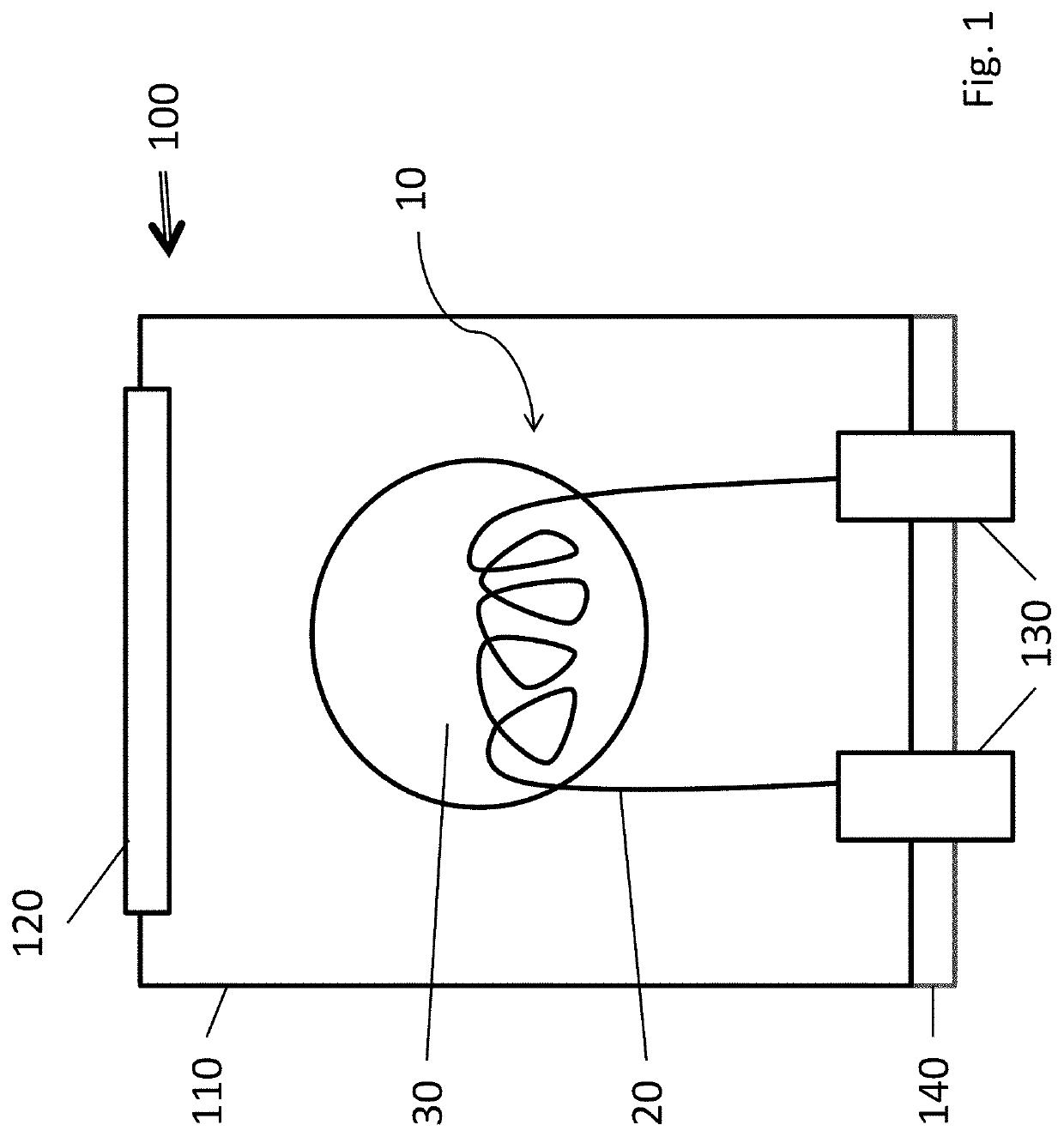Gas sensor, measuring element for a gas sensor and method for preparing a measuring element
a technology of gas sensor and measuring element, which is applied in the field of gas sensor, can solve the problems of insufficient robustness of sensors for some applications, limited free space available for correspondingly mounted sensors, and inability to reliably measure, etc., and achieves the effects of reducing energy consumption, improving sensitivity, and improving mechanical robustness
- Summary
- Abstract
- Description
- Claims
- Application Information
AI Technical Summary
Benefits of technology
Problems solved by technology
Method used
Image
Examples
example 1
[0051]To prepare a measuring element 10, as it can be seen in FIG. 2a, 2g of tris(ethylenediamine) rhodium(III) trichloride hydrate (Alfa Aesar, 10553) are dissolved in 10 mL of distilled water while stirring at approx. 50° C. Then, 200 mg of aluminum oxide (BDH Chemicals, 33138 2S) and 100 mg of zirconium dioxide (Sigma Aldrich, 544760) are added to 1 mL of the solution obtained and suspended in an ultrasonic bath for 10 minutes. The suspension is subsequently applied step by step to a platinum coil (diameter 25 μm, Heraeus), which forms the heating coil 20. Each step of application is followed by a drying step by sending a heating current of 70 mA through the platinum wire. The bead obtained in the preceding steps is calcined after the last coating and drying operation by setting the operating current of 115 mA. The rhodium salt, which is contained as a catalyst precursor in the coating solution, is converted now into rhodium oxide.
example 2
[0052]Glass fibers are provided as fibrous material to prepare a measuring element 10 according to the present invention with a corresponding ceramic 30. Commercially available glass fibers may be used, or the glass fibers are prepared from glass fiber mat as follows: 0.5 g of glass fiber mat (Munktell, MK360) is chopped into small pieces and added to 50 mL of distilled water. The glass fibers are then stirred gently for 24 hours, so that they can swell. The swollen mass of glass fiber mat, in which the glass fibers are present randomly and freely, is then dried at 60° C. for about 6 hours.
[0053]As was already described for Example 1, a suspension of 1 mL of tris(ethylenediamine) rhodium(III) trichloride solution, to which aluminum oxide and zirconium oxide were added, is then prepared and mixed with 2 mg of the dried glass fibers. The coating solution thus prepared is treated in an ultrasonic bath for 10 minutes. The suspension is then applied, as was likewise described for Example...
example 3
[0055]To prepare an alternative measuring element 10, which likewise corresponds to the state of the art, 2 g of tris-ethylenediamine) rhodium(III) trichloride hydrate (Alfa Aesar, 10553) are again dissolved in 10 mL of distilled water while stirring at approx. 50° C. Then, 200 mg of aluminum oxide (BDH Chemicals 33138 2S) and 75 mg of cerium oxide (Sigma Aldrich, 544841) are added to 1 mL of the solution obtained and suspended in an ultrasonic bath for 10 minutes. The further procedure is carried out as described already for Example 1 in this case as well.
PUM
| Property | Measurement | Unit |
|---|---|---|
| operating temperatures | aaaaa | aaaaa |
| operating temperatures | aaaaa | aaaaa |
| diameter | aaaaa | aaaaa |
Abstract
Description
Claims
Application Information
 Login to View More
Login to View More - R&D
- Intellectual Property
- Life Sciences
- Materials
- Tech Scout
- Unparalleled Data Quality
- Higher Quality Content
- 60% Fewer Hallucinations
Browse by: Latest US Patents, China's latest patents, Technical Efficacy Thesaurus, Application Domain, Technology Topic, Popular Technical Reports.
© 2025 PatSnap. All rights reserved.Legal|Privacy policy|Modern Slavery Act Transparency Statement|Sitemap|About US| Contact US: help@patsnap.com



